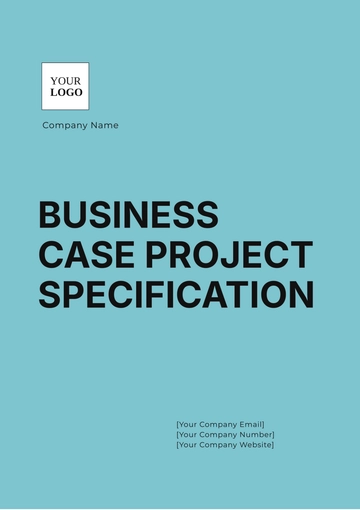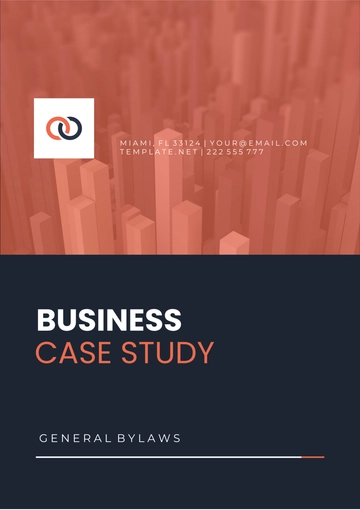Free B2B Case Study

I. Introduction
In today's dynamic business landscape, companies face multifaceted challenges that demand innovative solutions to stay ahead of the competition. [Your Company Name], a leading provider of [industry-specific solutions], understands the intricacies of these challenges and is committed to empowering businesses with tailored solutions that drive growth and efficiency. This case study delves into a real-world scenario where [Your Company Name] partnered with [Client Company] to overcome operational hurdles and achieve tangible business outcomes.
II. Client Background Summary:
[Client Company] is a multinational logistics conglomerate operating globally with a workforce of over 10,000 employees. Specializing in end-to-end logistics solutions, they serve a diverse clientele from small businesses to Fortune 500 companies. Despite their extensive experience, they faced challenges in optimizing last-mile delivery operations due to the surge in e-commerce and changing consumer expectations.
Issues such as route optimization and real-time tracking impacted operational costs and customer satisfaction. Seeking innovation, [Client Company] partnered with [Your Company Name] to explore solutions to enhance their last-mile logistics services.
III. Challenges Faced
A. Operational Inefficiencies:
[Client Company] struggled with inefficiencies in their last-mile delivery processes, particularly in route planning and driver scheduling. These inefficiencies resulted in frequent delays, increased operational costs, and decreased productivity. Despite their efforts to optimize operations manually, the lack of a streamlined system led to inefficiencies that negatively impacted their bottom line and customer satisfaction levels.
B. Lack of Scalability:
The existing systems and processes at [Client Company] were not designed to accommodate the rapid growth and fluctuations in demand characteristic of the logistics industry. As a result, they faced challenges in scaling their operations effectively to meet the evolving needs of their clients. The lack of scalability hindered their ability to expand into new markets, handle peak periods efficiently, and adapt to sudden changes in demand, thereby limiting their growth potential and competitiveness in the market.
C. Data Silos:
[Client Company]'s disjointed data system and fragmented, hard-to-access databases obstructed comprehensive operational insights, leading to subpar decision-making and missed opportunities. This adversely affected their growth and competitiveness in the industry.
IV. Solutions Provided
In response to [Client Company]'s challenges, [Your Company Name] proposed a comprehensive suite of solutions tailored to address their specific pain points and drive tangible business outcomes:
A. Implementation of [Your Solution/Product Name]
Streamlined Processes: With [Product Name], [Client Company] streamlined delivery processes, reduced redundancies, boosted efficiency, and improved service quality, leading to higher customer satisfaction. This was achieved through optimized planning, scheduling, sorting, and real-time tracking.
Scalability: [Product Name] provided a scalable and modular architecture designed for [Client Company]'s evolving needs, enabling efficient expansion and demand fluctuation management in new markets. It offered flexibility and preserved efficiency and service quality during peak periods, and rapid growth.
Integration Capabilities: [Product Name]'s seamless integration with [Client Company]'s systems broke down data silos, gave a unified operations view, and drove informed decision-making. Access to real-time insights further lets [Client Company] identify trends and optimize last-mile delivery operations.
B. Training and Support
Comprehensive Training: [Your Company Name] provided comprehensive training programs tailored to [Client Company]'s unique requirements, ensuring seamless adoption and utilization of the solution across all levels of the organization.
Ongoing Support: Post-implementation, [Your Company Name] offered continuous support and maintenance services, ensuring that [Client Company] remained equipped to leverage the full potential of the solution and address any emerging challenges effectively.
V. Results Achieved
The implementation of [Product Name] yielded significant results for [Client Company], driving measurable improvements across key operational areas:
Operational Efficiency:
Implementing [Product Name] led to a significant [percentage increase] boost in [Client Company]'s operational efficiency. Streamlined delivery processes, optimized routes, automated tasks, and real-time tracking reduced lead times, operational costs, order fulfillment, and improved customer satisfaction. Benefits also included reduced fuel consumption, lesser vehicle idle time, and better resource utilization.
Scalability and Flexibility:
[Product Name]'s scalable architecture allowed [Client Company] to adjust to market changes by modifying resources as required, managing demand efficiently, expand operations, and add new features for future scalability. This enhanced their market competitiveness and growth opportunities.
Data-driven Insights:
The consolidated data gave [Client Company] valuable insights into their delivery operations, allowing them to make good decisions to optimize processes, increase efficiency and understand customer preferences, leading to sustained growth in a tough logistics market.
VI. Conclusion
Through strategic collaboration and innovative solutions, [Your Company Name] empowered [Client Company] to overcome operational hurdles and achieve significant business growth. This case study serves as a testament to [Your Company Name]'s commitment to delivering value-driven solutions that drive tangible outcomes and foster long-term partnerships with clients.
Prepared By:
[Your Name]
[Your Position]
[Your Department]
Contact Details:
[Your Email]
[Your Company Name]
[Your Company Address]
Case Study Templates @ Template.net
- 100% Customizable, free editor
- Access 1 Million+ Templates, photo’s & graphics
- Download or share as a template
- Click and replace photos, graphics, text, backgrounds
- Resize, crop, AI write & more
- Access advanced editor
Unlock the potential of your B2B success stories with our premium Case Study Template, offered by Template.net. Craft compelling narratives effortlessly with our customizable, downloadable, and printable template. Tailor each detail to your brand's voice and style, all easily editable in our intuitive AI Editor Tool. Elevate your presentations and showcase your achievements with professionalism and ease.




